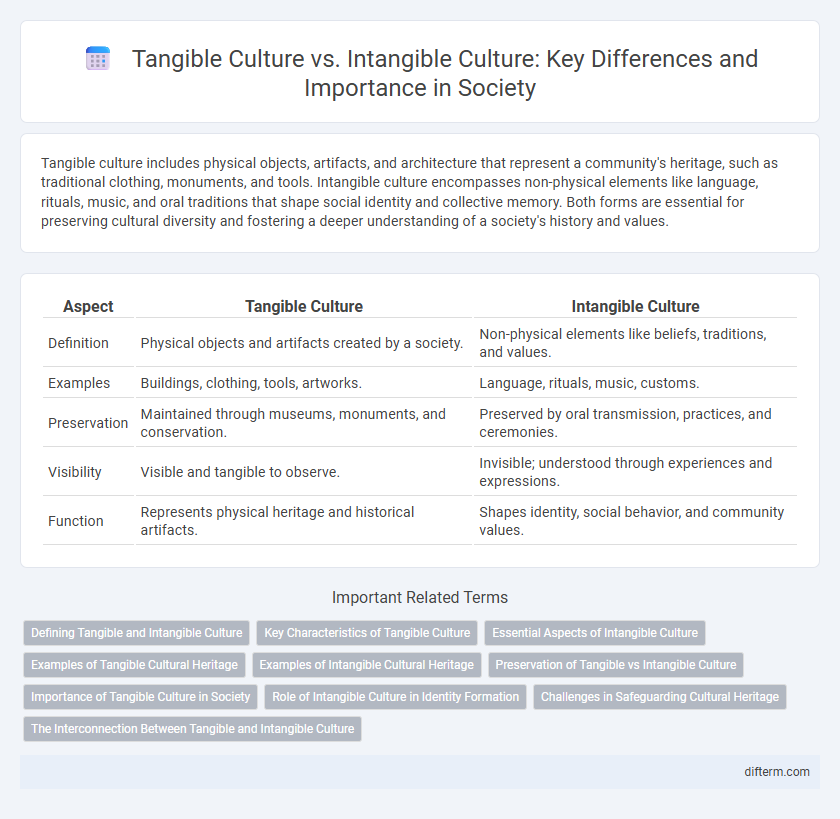Tangible culture includes physical objects, artifacts, and architecture that represent a community's heritage, such as traditional clothing, monuments, and tools. Intangible culture encompasses non-physical elements like language, rituals, music, and oral traditions that shape social identity and collective memory. Both forms are essential for preserving cultural diversity and fostering a deeper understanding of a society's history and values.
Table of Comparison
| Aspect | Tangible Culture | Intangible Culture |
|---|---|---|
| Definition | Physical objects and artifacts created by a society. | Non-physical elements like beliefs, traditions, and values. |
| Examples | Buildings, clothing, tools, artworks. | Language, rituals, music, customs. |
| Preservation | Maintained through museums, monuments, and conservation. | Preserved by oral transmission, practices, and ceremonies. |
| Visibility | Visible and tangible to observe. | Invisible; understood through experiences and expressions. |
| Function | Represents physical heritage and historical artifacts. | Shapes identity, social behavior, and community values. |
Defining Tangible and Intangible Culture
Tangible culture encompasses physical artifacts such as buildings, artworks, clothing, and tools that reflect a society's heritage and historical identity. Intangible culture includes non-physical elements like traditions, language, rituals, and knowledge passed down through generations, shaping social behaviors and communal values. Both forms interact closely to preserve cultural identity and foster continuity within communities worldwide.
Key Characteristics of Tangible Culture
Tangible culture encompasses physical objects and artifacts created, used, or valued by a society, including buildings, tools, clothing, and artworks. These material elements serve as concrete evidence of historical and cultural identity, providing insight into technological development, craftsmanship, and everyday life. Preservation of tangible culture is essential for heritage conservation, educational purposes, and strengthening community identity.
Essential Aspects of Intangible Culture
Intangible culture encompasses essential aspects such as oral traditions, performing arts, social practices, rituals, and festive events that shape community identity and continuity. Unlike tangible culture, which includes physical artifacts and monuments, intangible culture is transmitted through generations by word of mouth and practice, highlighting the dynamic and living nature of cultural heritage. Preserving intangible culture is vital for maintaining cultural diversity and fostering intercultural dialogue in a globalized world.
Examples of Tangible Cultural Heritage
Examples of tangible cultural heritage include historical monuments like the Great Wall of China, ancient artifacts such as Egyptian pottery, and traditional architecture exemplified by Japanese temples. These physical objects and sites provide insight into past civilizations and cultural practices, preserving their legacy through time. Museums and UNESCO World Heritage Sites play a crucial role in safeguarding tangible culture for future generations.
Examples of Intangible Cultural Heritage
Intangible cultural heritage encompasses traditions such as oral storytelling, performing arts, rituals, and festive events that communities pass down through generations. Examples include Japan's Noh theater, Spain's flamenco music and dance, and India's classical Bharatanatyam dance. These elements preserve cultural identity and foster social cohesion beyond physical artifacts.
Preservation of Tangible vs Intangible Culture
Preservation of tangible culture involves maintaining physical artifacts such as monuments, artworks, and historical buildings, which require conservation techniques to protect against decay and environmental damage. Intangible culture preservation focuses on safeguarding practices, expressions, knowledge, and skills like oral traditions, performing arts, and rituals through documentation, transmission, and community engagement. Both forms of cultural preservation demand tailored strategies to ensure heritage continuity and promote cultural identity across generations.
Importance of Tangible Culture in Society
Tangible culture encompasses physical artifacts, monuments, and artworks that serve as concrete representations of a society's heritage and identity. Preserving tangible culture fosters community cohesion, education, and historical continuity by providing accessible links to the past. These material expressions enable societies to showcase craftsmanship, traditions, and cultural evolution across generations.
Role of Intangible Culture in Identity Formation
Intangible culture, including language, rituals, and oral traditions, plays a crucial role in shaping personal and collective identity by preserving shared values and historical narratives. Unlike tangible culture, which consists of physical artifacts, intangible culture fosters emotional connections and social cohesion through lived experiences and symbolic meanings. This dynamic aspect of culture ensures continuity and adaptability, enabling communities to maintain a sense of belonging across generations.
Challenges in Safeguarding Cultural Heritage
Protecting tangible cultural heritage such as monuments and artifacts faces challenges like environmental degradation, urbanization, and insufficient funding for conservation efforts. Intangible cultural heritage, including traditions, languages, and rituals, risks extinction due to globalization, loss of practitioners, and lack of documentation. Effective safeguarding requires integrated strategies that address both physical preservation and the transmission of cultural knowledge across generations.
The Interconnection Between Tangible and Intangible Culture
Tangible culture, which includes physical artifacts like monuments, clothing, and art, serves as a crucial repository for intangible culture such as traditions, languages, and rituals. The preservation of tangible culture often ensures the survival of intangible elements by providing a contextual framework that supports the transmission of cultural knowledge across generations. Understanding their interconnection reveals how both forms collectively contribute to a society's identity and continuity.
tangible culture vs intangible culture Infographic

 difterm.com
difterm.com